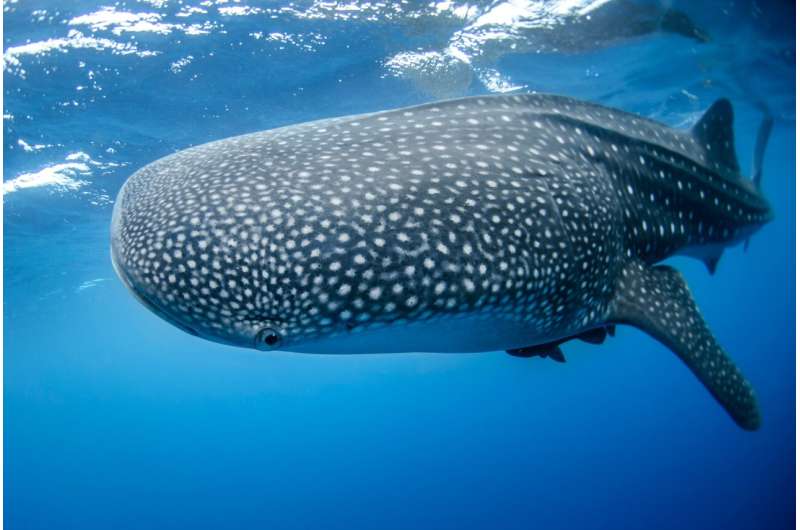This article has been reviewed according to Science X's editorial process and policies. Editors have highlighted the following attributes while ensuring the content's credibility:
fact-checked
trusted source
proofread
Globe-spanning golden trevally population may hitchhike with whale sharks

Researchers may have an answer to the mystery of why an anglers' favorite, the golden trevally, is so widespread globally—the prized fish might 'hitchhike' with whale sharks.
Associate Professor Nathan Waltham from James Cook University's Center for Tropical Water and Aquatic Ecosystem Research took part in a preliminary investigation with a team of coastal ecology academics.
He said the golden trevally is a large predatory fish with an extremely broad distribution spanning substantial barriers.
"They're found in a band from the east coast of Africa across to the west coast of North America and from islands south of Japan to northern Australia. Golden trevally appear not to be affected by biogeographic boundaries that constrain the distributions of most other species with reef or coastal associated adults.
"Such an unusually extensive range, coupled with relatively low densities, suggests that golden trevally have an unusual life history and/or dispersal mechanism," said Dr. Waltham.
He said researchers set out to make a simple check of an intriguing theory.
"Both published information and freely available imagery suggest small juvenile Golden Trevally are often associated with whale sharks, which could explain the unusually widespread distribution of the trevally and suggests a novel nursery relationship," said Dr. Waltham.
The team systematically examined images of trevally available on the internet.
Dr. Waltham said 60% of the images featuring trevally in close association with other sea creatures showed them with whale sharks.
"All of the trevally close to whale sharks were juveniles or sub-adults, and in many cases, they were seen close to the sharks' mouths," said JCU's Distinguished Professor Marcus Sheaves, who was also involved in the project.
He said researchers had determined with hydrodynamic models that the front of whale sharks seems to be where small fish benefit the most from reduced drag, thereby reducing their "travel costs."
"Whale sharks are known to undertake extremely long-distance migrations over short periods of time. So, it could be possible for juvenile Golden Trevally to make those same migrations by essentially hitchhiking with whale sharks," said Professor Sheaves.
He said stable isotope and genetic analysis would be needed to definitively prove the connection.
"If we can do that, it has implications for the management of both Golden Trevally and whale sharks. A mobile nursery relationship extends the concept of connectivity between spawning, nursery and adult habitats beyond the scope of local-scale management, into the more complex international realm.
"Additionally, the possible presence of this unusual nursery relationship brings into question the relevance of this or similar models for other species."
Provided by James Cook University


















